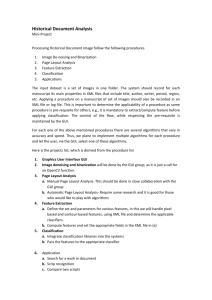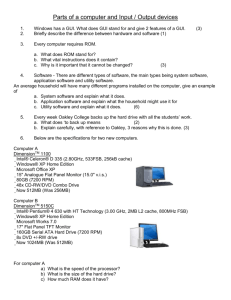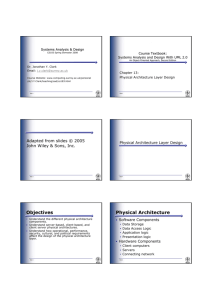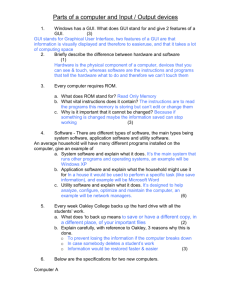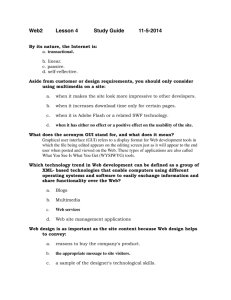Client server is network architecture which
advertisement
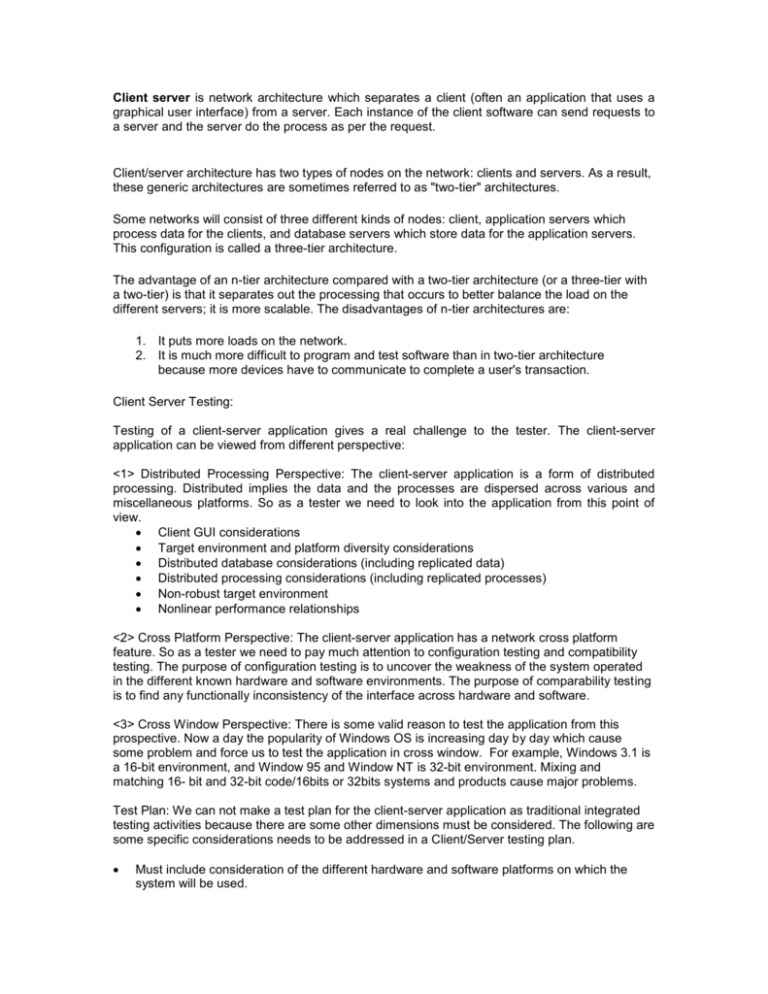
Client server is network architecture which separates a client (often an application that uses a graphical user interface) from a server. Each instance of the client software can send requests to a server and the server do the process as per the request. Client/server architecture has two types of nodes on the network: clients and servers. As a result, these generic architectures are sometimes referred to as "two-tier" architectures. Some networks will consist of three different kinds of nodes: client, application servers which process data for the clients, and database servers which store data for the application servers. This configuration is called a three-tier architecture. The advantage of an n-tier architecture compared with a two-tier architecture (or a three-tier with a two-tier) is that it separates out the processing that occurs to better balance the load on the different servers; it is more scalable. The disadvantages of n-tier architectures are: 1. It puts more loads on the network. 2. It is much more difficult to program and test software than in two-tier architecture because more devices have to communicate to complete a user's transaction. Client Server Testing: Testing of a client-server application gives a real challenge to the tester. The client-server application can be viewed from different perspective: <1> Distributed Processing Perspective: The client-server application is a form of distributed processing. Distributed implies the data and the processes are dispersed across various and miscellaneous platforms. So as a tester we need to look into the application from this point of view. Client GUI considerations Target environment and platform diversity considerations Distributed database considerations (including replicated data) Distributed processing considerations (including replicated processes) Non-robust target environment Nonlinear performance relationships <2> Cross Platform Perspective: The client-server application has a network cross platform feature. So as a tester we need to pay much attention to configuration testing and compatibility testing. The purpose of configuration testing is to uncover the weakness of the system operated in the different known hardware and software environments. The purpose of comparability testing is to find any functionally inconsistency of the interface across hardware and software. <3> Cross Window Perspective: There is some valid reason to test the application from this prospective. Now a day the popularity of Windows OS is increasing day by day which cause some problem and force us to test the application in cross window. For example, Windows 3.1 is a 16-bit environment, and Window 95 and Window NT is 32-bit environment. Mixing and matching 16- bit and 32-bit code/16bits or 32bits systems and products cause major problems. Test Plan: We can not make a test plan for the client-server application as traditional integrated testing activities because there are some other dimensions must be considered. The following are some specific considerations needs to be addressed in a Client/Server testing plan. Must include consideration of the different hardware and software platforms on which the system will be used. Must take into account network and database server performance issues with which mainframe systems did not have to deal. Has to consider the replication of data and processes across networked servers Following are the kind of testing which are included in the test plan: a. The system test plan: System test scenarios are a set of test scripts, which reflect user behaviors in a typical business situation. It’s very important to identify the business scenarios before constructing the system test plan. b. The user acceptance test plan: The user acceptance test plan is very similar to the system test plan. The major difference is the direction. The user acceptance test is designed to demonstrate the major system features to the user as opposed to finding new errors. c. The regression test plan: The regression test plan occurs at two levels. In Client/Server development, regression testing happens between builds. Between system releases, regression testing also occurs postproduction. Each new build/release must be tested for three aspects: To resolve errors introduced by the fix into previously correct function. To resolve previously reported errors To resolve errors in the new functionality. d. Multi-user performance test plan: It is necessary to be performed in order to uncover any unexpected system performance problem under load. Test Process: These human testing procedures have been found to be very effective in the prevention and early correction of errors. It has been documented that two-thirds of all of the errors in finished information systems are the results of logic flaws rather than poor coding. Preventive testing approaches, such as walkthroughs and inspections can eliminate the majority of these analysis and design errors before they go through to the production system. <1> Client Side testing: GUI Testing >> a. Cross-platform nature: The same GUI objects may be required to run transparently (provide a consistent interface across platforms, with the cross-platform nature unknown to the user) on different hardware and software platforms. b. Event-driven nature: GUI-base applications have increased testing requirements because they are in an event-driven environment where user actions are events that determine the application’s behavior. Because the number of available user actions is very high, the number of logical paths in the supporting program code is also very high. c. The mouse, as an alternate method of input, also raises some problems. It is necessary to assure that the application handles both mouse input and keyboard input correctly. d. The GUI testing also requires testing for the existence of a file that provides supporting data/information for text objects. The application must be sensitive to the existence, or nonexistence. e. In many cases, GUI testing also involves the testing of the function that allows end-users to customize GUI objects. Many GUI development tools give the users the ability to define their own GUI objects. The ability to do this requires the underlying application to be able to recognize and process events related to these custom objects. Data Validation Techniques >> Some of the most serious errors in software systems have been the result of inadequate or missing input validation procedures. Software testing has powerful data validation procedures in the form of the Black Box techniques of Equivalence Partitioning, Boundary Analysis, and Error Guessing. These techniques are also very useful in GUI testing. Scenario Testing >> It is a system-level Black Box approach that also assures good White Box logic-level coverage for Client/Server systems. Functional Testing >> DLT (decision logic table) represents an external view of the functional specification that can be used to supplement scenario testing from a logic-coverage perspective. In DLTs, each logical condition in the specification becomes a control path in the finished system. Each rule in the table describes a specific instance of a pathway that must be implemented. Hence, test cases based on the rules in a DLT provide adequate coverage of the module’s logic independent of its coded implementation. <2> Server Side Testing: Client/Server loading tests >> Client/Server systems must undergo two types of testing: single-user-functional-based testing and multi-user loading testing. Multiuser loading testing is the best method to measure Client/Server performance. It is necessary in order to determine the suitability of application server, database server, and web server performance. Because multi-user load test requires emulating a situation in which multiple clients access a single server application, it is almost impossible to be done without automation. For the Client/Server load testing, some common objectives include: Measuring the length of time to complete an entire task Discovering which hardware/software configuration provides optimal performance Tuning database queries for optimal response Capturing Mean-Time-To-Failure as a measure of reliability Measuring system capacity to handle loads without performance degradation Identifying performance bottlenecks Based on the test objectives, a set of performance measurements should be described. Typical measurements include: End-to-end response time Network response time GUI response time Server response time Middleware response time Volume testing >> The purpose of volume testing is to find weaknesses in the system with respect to its handling of large amount of data during extended time periods 3.1.1 Stress testing: The purpose of stress testing is to find defects of the system capacity of handling large numbers of transactions during peak periods. For example, a script might require users to login and proceed with their daily activities while, at the same time, requiring that a series of workstations emulating a large number of other systems are running recorded scripts that add, update, or delete from the database. Performance testing >> System performance is generally assessed in terms of response time and throughput rates under differing processing and configuration conditions. To attack the performance problems, there are several questions should be asked first: How much application logic should be remotely executed? How much updating should be done to the database server over the network from the client workstation? How much data should be sent to each in each transaction? Other server side testing related to data storage >> Data recovery testing Data backup and restoring testing Data security testing Replicated data integrity testing. <3> Testing the Network: Network testing is basically done by the network management group. Elements of network testing include: Application response time measures Application functionality Throughput and performance measurement Configuration and sizing Stress testing and performance testing Reliability It is necessary to measure application response time while the application is completing a series of tasks. This kind of measure reflects the user’s perception of the network, and is applicable through the entire network life cycle phase. Testing application functionality involves testing shared functionality across workstations, shared data, and shared processes. This type of testing is applicable during the development and evolution. Configuration and sizing measure the response of specific system configurations. This is done for different network configurations until the desired performance level is reached. . The point of stress testing is to overload network resource such as routers or hubs. Performance testing can be used to determine how many network devices will be required to meet the network’s performance requirements. Reliability testing involves running the network for 24-72 hrs under a medium-to-heavy load. From a reliability point of view, it is important that the network remain functional in the event of a node failure. <4> Security Testing: For internet-based Client/Server systems, security testing for the web server is very very important. The web server is LAN’s window to the world and, conversely, is the world’s window to the LAN. Three types of security risks have been identified [15]: 1. The primary risk is errors in the web server side misconfiguration that would allow remote users to: Steal confidential information Execute commands on the server host, thus allowing the users to modify the system Gain information about the server host that would allow them to break into the system Launch attacks that will bring the system down. 2. The secondary risk occurs on the Browser-side Active content that crashes the browser, damages your system, breaches your company’s privacy, or creates an annoyance. The misuse of personal information provided by the end user. 3. The third risk is data interception during data transfer. The above risks are also the focuses of web server security testing. As a tester, it is our responsibility to test if the security extends provided by the server meet the user’s expectation for the network security. Tapas Kumar Sahoo. (www.mindfiresolutions.com)



